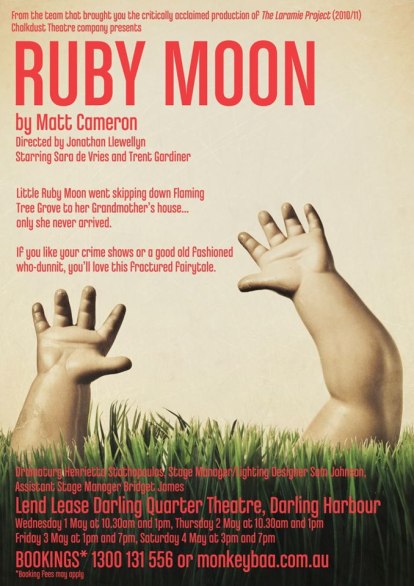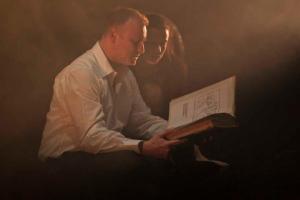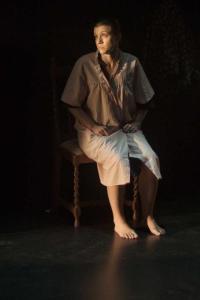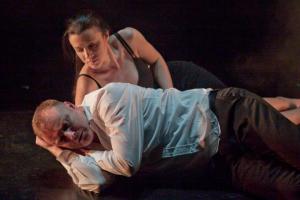Hazy Moon – A Chalkdust Theatre Production
Matt Cameron’s Ruby Moon (2003) has become something of a contemporary Australian classic over the last decade. As a result, it is frequently performed which creates the challenge for each new adaptation to distinguish itself from the pack. Chalkdust Theatre’s latest production offers some new twists.
Ray and Sylvie Moon live on Flaming Tree Grove, in suburban heartland. Their daughter, Ruby, has been missing for some time, and they are struggling to deal with their loss. On this particular evening however, something very different happens: a new clue comes to light. With a glimmer of hope, Ray and Sylvie set off once again down the street to question the collection of quirky neighbours. Yet, as the play progresses, it becomes apparent that the parents are playing the litany of characters themselves. So no matter how far they dig, nothing new will ever come to light. They are working in a closed system. By the play’s end, it would seem that the question is not what happened to Ruby, but rather how do we cope with a loss. The script is textually very rich with elements of absurdism, fairy-tales, detective fiction and a plot that won’t resolve, leaving plenty of room for interpretation.
Director Jonathan Llewellyn has done a wonderful job with the lighting and set. A corridor of light and a constant shroud of mist create a claustrophobic atmosphere, which drives home the idea that these characters are caught in a closed universe. They may seek new information but when everything is of their own construction nothing new can reach them and what information there is, is cloudy and undefined. Props seem to float in and out of the light giving the piece an eerie dream-like quality. During the Q&A session Llewellyn stated that his intention had been to present the play as a collection of fragmented and distorted memories, and although the text could potentially support such a reading, on viewing it wasn’t particularly evident. Indeed, outside of the creative lighting and set choices the play appeared to offer a pretty straightforward interpretation. This is a definite shame as the idea of memory, if it had been developed further, could have made for interesting theatre.
Although there are some eight characters in the play, there are only two actors, making this 90-minute piece something of a performance marathon as the actors are required to play four roles each. Certainly, it’s a difficult task, especially when you have to snap in and out of characters at a moment’s notice. Unfortunately, at times both Sara de Vries and Trent Gardiner struggled to achieve this. Pacing inadvertently caused the biggest difficulty. Whilst the speed certainly dealt with some of the more problematic dialogue, notably in the first scene, the actors often went too fast, not giving themselves enough time to think. Consequently, the dialogue wasn’t always genuine. Further, the Ray and Sylvie scenes were consistently angst ridden. Emotions ran high from start to finish, and although both tried to map their character’s journey, it was frequently lost behind a constant stream of ‘generic raised voice’.
Of Trent Gardiner, the piece requires that he play a misunderstood clown, an intense ex-soldier and a guilt-ridden professor all on top of the emptiness of a grief stricken father. Gardiner often lacked the energy required to pull off some of the more erratic characters. His choices were basically right, but many laughs were lost because he opted once again for generic angst.
Sara de Vries, who arguably had a more difficult task, was required to play an old religious spinster, a washed up cabaret singer, a disturbed babysitter as well as carry off the borderline madness of a lonely mother. Similar to Gardiner, de Vries often opted for generic angst. This sometimes collapsed one character into another, but in the wrong way. Of de Vries, more variation was required. This could have been achieved, at least in part, with further costuming. Nevertheless, de Vries moved very well – she was always graceful and produced a very fine interpretation of Dawn the disturbed babysitter – this too was Gardiner’s best scene.
Generally, both de Vries and Gardiner possessed some very fine stagecraft – a testament to the amount of hours that were surely put in. Ultimately though they fell short of making us believe they’d lost a child. Although this production may not add much to the plethora of Ruby Moon adaptations which have come before it did however contain some nice ideas and the standard of performance is certainly noteworthy when it is considered that this was not professionally produced.
Unfortunately Ruby Moon has now finished its run, it was however performed at the Darling Quarter Theatre.





